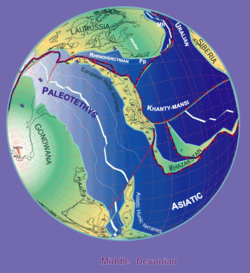Frasnian
| Frasnian | |||||||||||||||||
|---|---|---|---|---|---|---|---|---|---|---|---|---|---|---|---|---|---|
 Paleogeography of the Late Devonian, 380 Ma | |||||||||||||||||
| Chronology | |||||||||||||||||
| |||||||||||||||||
| Etymology | |||||||||||||||||
| Name formality | Formal | ||||||||||||||||
| Usage information | |||||||||||||||||
| Celestial body | Earth | ||||||||||||||||
| Regional usage | Global (ICS) | ||||||||||||||||
| Time scale(s) used | ICS Time Scale | ||||||||||||||||
| Definition | |||||||||||||||||
| Chronological unit | Age | ||||||||||||||||
| Stratigraphic unit | Stage | ||||||||||||||||
| Time span formality | Formal | ||||||||||||||||
| Lower boundary definition | FAD of the conodont Ancyrodella rotundiloba | ||||||||||||||||
| Lower boundary GSSP | Col du Puech de la Suque, Montagne Noire, France 43°30′12″N 3°05′12″E / 43.5032°N 3.0868°E | ||||||||||||||||
| Lower GSSP ratified | 1986[5] | ||||||||||||||||
| Upper boundary definition | FAD of the conodont Palmatolepis triangularis LAD of the conodonts Ancyrodella and Ozarkodina and the goniatites Gephuroceratidae and Beloceratidae | ||||||||||||||||
| Upper boundary GSSP | Coumiac quarry, Montagne Noire, France 43°27′41″N 3°02′25″E / 43.4613°N 3.0403°E | ||||||||||||||||
| Upper GSSP ratified | 1993[6] | ||||||||||||||||
The Frasnian is one of two faunal stages in the Late Devonian Period. It lasted from 382.7 million years ago to 372.2 million years ago. It was preceded by the Givetian Stage and followed by the Famennian Stage.
Major reef-building was under way during the Frasnian Stage, particularly in western Canada and Australia. On land, the first forests were taking shape. In North America, the Antler orogeny peaked, which were contemporary with the Bretonic phase of the Variscan orogeny in Europe.
The Frasnian coincides with the second half of the "charcoal gap" in the fossil record, a time when atmospheric oxygen levels were below 13 percent, the minimum necessary to sustain wildfires.[7]
North American subdivisions of the Frasnian include
Name and definition
[edit]The Frasnian Stage was proposed in 1879 by French geologist Jules Gosselet and was accepted for the lower stage of the Upper Devonian by the Subcommission on Devonian Stratigraphy in 1981.[8] It is named after the village of Frasnes-lez-Couvin, in the district of Couvin, in Belgium.[9]
References
[edit]- ^ Parry, S. F.; Noble, S. R.; Crowley, Q. G.; Wellman, C. H. (2011). "A high-precision U–Pb age constraint on the Rhynie Chert Konservat-Lagerstätte: time scale and other implications". Journal of the Geological Society. 168 (4). London: Geological Society: 863–872. doi:10.1144/0016-76492010-043.
- ^ Kaufmann, B.; Trapp, E.; Mezger, K. (2004). "The numerical age of the Upper Frasnian (Upper Devonian) Kellwasser horizons: A new U-Pb zircon date from Steinbruch Schmidt(Kellerwald, Germany)". The Journal of Geology. 112 (4): 495–501. Bibcode:2004JG....112..495K. doi:10.1086/421077.
- ^ Algeo, T. J. (1998). "Terrestrial-marine teleconnections in the Devonian: links between the evolution of land plants, weathering processes, and marine anoxic events". Philosophical Transactions of the Royal Society B: Biological Sciences. 353 (1365): 113–130. doi:10.1098/rstb.1998.0195.
- ^ "Chart/Time Scale". www.stratigraphy.org. International Commission on Stratigraphy.
- ^ Klapper, Gilbert; Feist, Raimund; House, Michael (June 1987). "Decision on the Boundary Stratotype for the Middle/Upper Devonian Series Boundary". Episodes. 10 (2): 97–101. doi:10.18814/epiiugs/1987/v10i2/004. Retrieved 19 December 2020.
- ^ Klapper, G.; Feist, R.; Becker, R.; House, M. (December 1993). "Definition of the Frasnian/Famennian Stage boundary". 16 (4): 433–441. Retrieved 19 December 2020.
{{cite journal}}: Cite journal requires|journal=(help) - ^ McGhee, George R. Jr. (12 November 2013). When the Invasion of Land Failed: The Legacy of the Devonian Extinctions. Columbia University Press. pp. 110–11. ISBN 978-0-231-16057-5. Retrieved 21 April 2015.
- ^ Coen-Aubert, Marie; Boulvain, Frédéric (2006). "Frasnian". Geologica Belgica. 9 (1–2): 19–25. Retrieved 10 March 2013.[permanent dead link]
- ^ "Frasnian mudmounds from Belgium". University of Liège. Archived from the original on 2011-07-06. Retrieved 2011-02-25.
43°30′12″N 3°05′12″E / 43.5032°N 3.0868°E
